18/02/2022 • Blog, Product Reviews, Comparisons
Maple vs. Oak: A Comparison of Kitchen Cabinet Materials
Not sure if you should go with maple or oak for your kitchen cabinets?
Both are popular solid wood choices, so how do you decide which is better?
At Deslaurier, we’re experts in all things kitchen cabinets. As two of our most popular cabinet materials, we know how important it is to inform our clients of the differences and similarities between maple and oak.
This article will take you through all the characteristics of maple and oak as kitchen cabinet materials. We’ll compare the two options side by side to help you determine which wood species is right for your kitchen cabinets.
Let’s get to it!
|
Table of Contents |
|
A Note on Maple and Oak Cabinets Maple vs. Oak Cabinets: Appearance Maple vs. Oak Cabinets: Strength Maple vs. Oak Cabinets: Finishing Options |
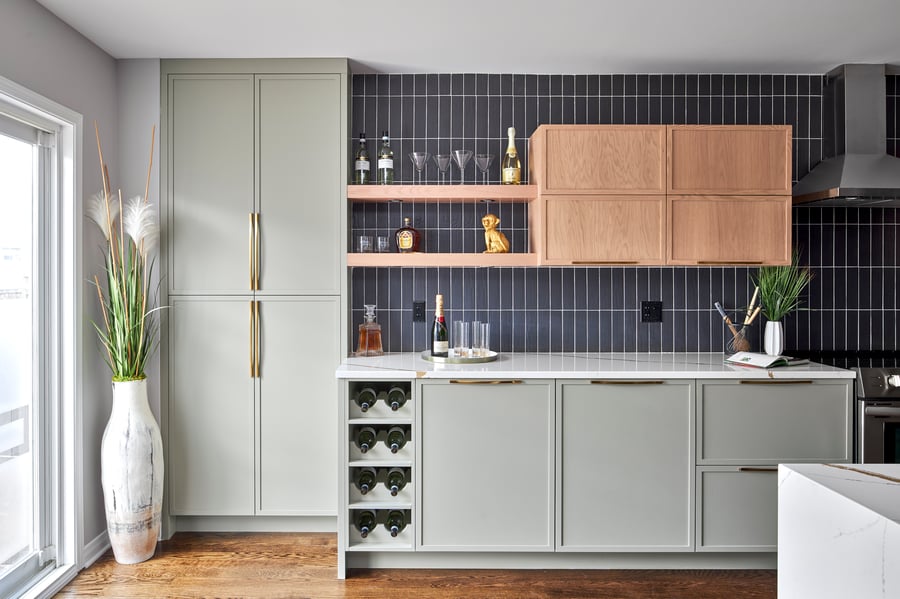
A Note on Maple and Oak Cabinets
It’s worth noting that not all maples and oaks are alike. Technically speaking, there are several different varieties of both maple and oak, and each one is slightly different from the next.
There are two major types of oak: red oak and white oak.
White oak is typically stronger and rot-resistant, making it more inclined to be used outdoors or for boats. That being said, white oak has become increasingly popular over the years for elegant (and more expensive) hardwood flooring and kitchen cabinets.
Red oak will often be slightly less durable, less expensive, and best suited for interior builds like cabinets. For the purposes of this article, we’ll focus on traditional red oak.
Similarly, there are two distinct types of maple: hard and soft maple.
The differences between these two categories are major, so it’s crucial we clarify which we’re talking about. For this comparison of cabinet materials, soft maples are irrelevant because almost all cabinet makers (including Deslaurier) use hard maple for cabinet doors.
For the purposes of this article, we’ll be comparing hard maple to red oak.
With that established, let’s move on to the appearance of maple vs oak.
Maple vs. Oak Cabinets: Appearance
Unlike the wood grain similarities of maple and birch, maple and oak are uniquely different when it comes to their appearance.
Maple’s grain is simple and subtle. It is generally white with reddish-brown hues. While maple’s grain pattern is generally quite straight, it does have some waves and curls to it.
Oak is a light to middle brown colour with a cast of red. It has a prominent, straight grain pattern.
Take a look at maple and oak side by side below, with maple on the left and oak on the right:
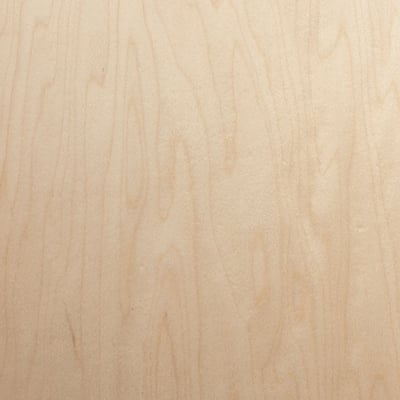
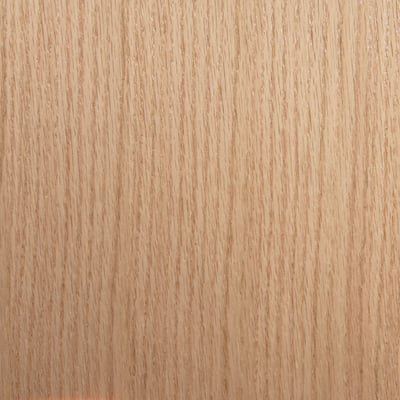
Remember, hardwood products are natural products—just like the trees themselves, no two cabinet doors are exactly alike. There will always be differences from one slab to the next, and that’s part of their beauty!
Another aesthetic difference is that maple tends to have a very smooth and shiny surface. In comparison, oak has a slightly raised wood grain that results in a rougher, coarser texture.
Maple vs. Oak Cabinets: Strength
When it comes to strength and durability, maple and oak are some of the best kitchen cabinet materials you can have. After all, they’re both hardwoods.
That being said, maple is a slightly stronger hardwood product than oak. Maple is one of the strongest and most durable natural wood options available. It holds up well resisting significant dents or dings.
We’ll use the Janka Hardness Scale as reference. The Janka scale is used to determine the strength and hardness of various wood species. The higher the rating, the harder the wood is.
Hard maple has a hardness rating of roughly 1450, while red oak comes in slightly lower at 1290.
Now, if you’re careful around your cabinets, this difference in strength may be negligible to you as a user. Oak is still a strong and durable hardwood choice for kitchen cabinets.
But, if you were to put maple and oak to the test to see which one would resist denting and scratching, hard maple would perform slightly better. Ultimately, you’re really splitting hairs when it comes to durability.
Planning to renovate your kitchen? Our downloadable comprehensive guide will prepare you for every step of the kitchen renovation journey!
Maple vs. Oak Cabinets: Finishing Options
The way maple and oak take to different finishes, like stains and paints (see our article comparing stained vs. painted cabinets), is often a big consideration in a homeowner’s cabinet selection.
After all, when you’re choosing your kitchen cabinets, it often comes down to an aesthetic decision.
Stains
Cabinets stains are a great choice for both maple and oak cabinets to highlight the beautiful, natural character of each wood species’ grain.
As we mentioned earlier, oak has a rougher texture than maple, which translates into a more matte stained finish. On the other hand, stained maple appears glossy because of its smooth texture.
Oak’s prominent grain makes it ideal for staining, as its texture will emerge proudly through a stained finish.
Depending on your aesthetic preferences, you may prefer the smooth shine of maple or the coarse, raised texture of oak. Of course, you can always counteract the natural surface of the wood by using a high-gloss or matte top coat.
The beauty of staining natural wood is that you can go as light or as dark as you want: from a clear coat to almost a black. Take a look at these dark-stained maple cabinets:
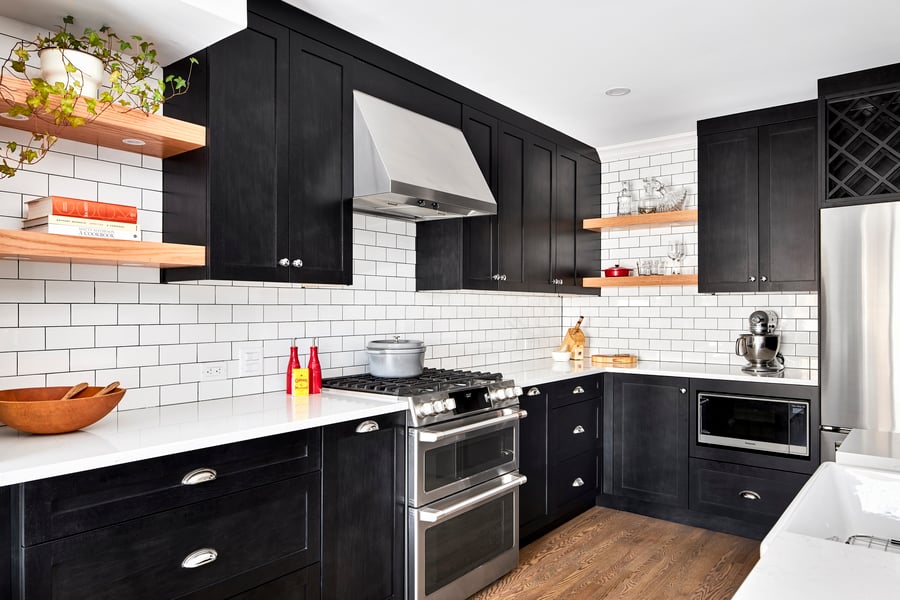
These cabinets have such a dark stain that from a distance, they almost appear to be painted. As you get closer, however, you see the subtle maple grain pattern emerge triumphantly.
Paints
When it comes to natural wood species, maple is as good as it gets for painted cabinets. That’s because maple is considered a paint-grade hardwood thanks to its low-key grain and uniform surface.
Unlike the smooth surface of maple, oak has an uneven and coarse texture that offers a unique finish compared to traditional painted cabinets. This texture means that you will both see and feel oak’s wood grain through the painted finish. This makes oak an ideal selection if you want your painted cabinets to have a more distinct quality to them.
If you want to paint your cabinets, you should know that all painted finishes require a high level of maintenance to prevent dings and dents. There are no underlying wood species that can protect your painted finish from damage 100%.
Also, since both maple and oak are solid woods (and therefore, living, breathing products), both of these wood species will expand and contract with humidity changes.
Over time, that slow expansion and contraction will cause stress cracks in the paint wherever there are joints in the cabinet door.
Both maple and oak are equally susceptible to cracks, as shown below:
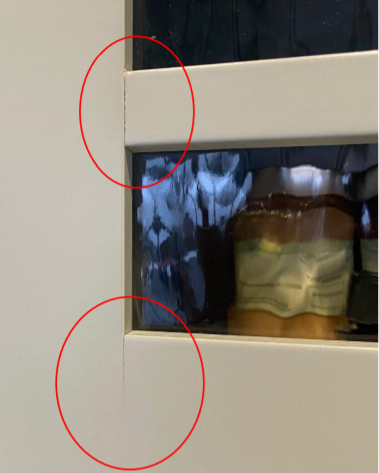
If you want to prevent cracks, choosing a non-hardwood material like MDF cabinets is your best bet.
Although the point of this article is to compare oak and maple cabinets, we thought MDF was worth mentioning because it’s an ideal product for painted finishes.
While not entirely impervious to cracking, MDF (medium-density fibreboard) is a manmade product formed by combining resins with different hardwood and softwood fibres. As a result, MDF is a more stable wood product than birch or maple—meaning it’s less likely to crack due to the natural occurrence of breathing.
If you want to see how MDF cabinets fare against natural wood, check out our Learning Centre page for our article on MDF vs. Natural Wood Cabinets!
Maple vs. Oak Cabinets: Cost
As has been the case throughout most of these comparisons, the cost of maple and oak kitchen cabinets are quite similar.
It’s also interesting to note that maple and oak are typically less expensive than most other more exotic hardwoods. That’s because maple and oak are grown all over North America and are easier to source.
Generally speaking, maple and oak fall somewhere in the middle when it comes to kitchen cabinet pricing. They’re both less expensive than high-end products that are harder to source, like walnut and cherry, while costing more than hickory, pine, or birch.
However, cost is always dependent on the grade of the wood, market conditions, and manufacturer.
For example, at Deslaurier, we source very high grades of wood, and our maple and oak cabinets are equivalent as far as purchase price.
This may not be the case with another cabinet maker.
Due to market factors, the cost of maple and oak can flip-flop. In years past, hard maple has been more expensive than red oak. However, in recent years the cost of oak has increased higher than maple.
This increase in oak is in large part due to the rise in popularity and in-trend style of white oak. Thanks to this, oak has become more in-demand, which has caused its price to surpass that of maple.
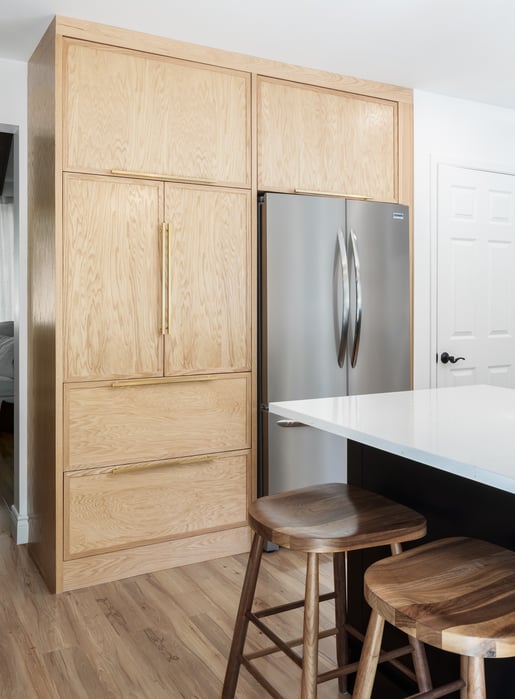
Maple vs. Oak Cabinets: What’s Right For You?
Although maple is often viewed as a superior and high-grade hardwood, we’ve seen that apart from its strength, maple is comparable to oak on most counts.
There’s no clear frontrunner between maple and oak: both are worthwhile options for kitchen cabinetry. The decision will ultimately come down to your personal aesthetic preferences.
If you desire a smooth surface, be it for a uniform painted finish or to adorn with a subtle stain, then maple cabinets are the better choice. If it’s a prominent, textured grain you’re after, then oak is the better selection.
Ultimately, it’s always important to weigh your budget, your finish choice, and your lifestyle to choose the best cabinet wood species for your dream kitchen.
Discover Deslaurier Custom Cabinets
Want to inspect the differences of maple and oak cabinets for yourself? Book a free consultation with a Deslaurier kitchen expert at our Ottawa showroom!
If you have your eye on custom cabinetry, Deslaurier Custom Cabinets has everything you need. With over 40 years of experience to our name, we provide our clients with a wholly customized design process with our talented team of designers.
Interested in becoming an authorized Deslaurier dealer? Visit our Become a Dealer page to learn more!
.png?width=224&height=80&name=Final%20(3).png)




